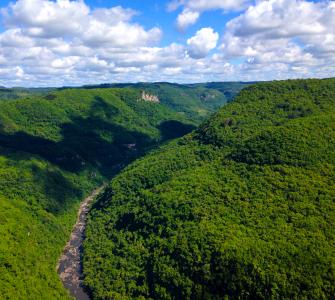The objectives of this analysis were to a) identify Conservation Agreement (CA) program characteristics that deliver effectiveness, b) assess how these characteristics are taken into account by CA programs in the Amazon regions of Brazil, Colombia and Peru, and c) provide recommendations regarding opportunities for ASL to support the effective use of CAs in the region. The study methodology included four steps:
- Identification and description of a set of focal CA programs in the region, based on meeting the specified criteria, literature, and consultation with national and international experts.
- Identification of CA program characteristics that contribute to effectiveness globally, based on a thorough literature review of a) synthesis studies, b) impact evaluations of CA programs in the region, and c) notable other studies of CA and PES, as well as d) expert consultation.
- Evaluation of the focal in-region CA programs against the identified characteristics, considering both how each characteristic is currently included in design and implementation, and which characteristics represent the greatest opportunities to improve performance.
- Recommendations, based on the findings of the study and aimed at being used by ASL implementers as well as other project managers in the Amazon region and beyond.
Based on literature review and expert consultation, the study identifies 30 characteristics that potentially contribute to CA program effectiveness globally. The study also suggests six opportunities for the ASL coordination project and/or ASL national projects to increase the use of best practices in key issues for CA effectiveness, which are strategic for the fulfillment of ASL national and regional program objectives. Download the full report.
The Amazon Sustainable Landscapes (ASL) Program was approved by the Global Environment Facility (GEF) Council in October 2015. Its objective is to protect globally significant biodiversity and implement policies to foster sustainable land use and restoration of native vegetation cover. The ASL Program is implemented via national projects in Brazil, Colombia, and Peru, and a regional coordination project, with support from the World Bank Group as the ASL lead agency, the World Wildlife Fund (WWF) and the United Nations Development Programme (UNDP).
The three countries where ASL operates have launched a range of initiatives to promote conservation, sustainable development, and reduction in greenhouse gas emissions. Among these are Conservation Agreement (CA) and Payment for Ecosystem Services (PES) programs. These programs are based on voluntary agreements that provide legal and de facto landowners with a range of benefits conditional on specified conservation actions or outcomes. The logic underlying these approaches is that for rural property-owners, conservation often means incurring both direct costs and sacrificing future income. By directly linking sustainable practices with an externally provided stream of benefits, conservation can be converted into an economically attractive choice.
Development of CA and PES programs has grown rapidly around the world. However, evidence on performance is mixed. Of particular concern is the finding that in many programs, the majority of land enrolled would not have been cleared or degraded, regardless of CA-provided benefits. CA programs that aim to reduce deforestation or otherwise change behavior with respect to the environment should therefore consider effectiveness not in terms of area enrolled, but in terms of additionality – how much more conservation will happen as a result of the CA program than would have happened without it. Effectiveness also depends on the environmental importance of land enrolled, and contribution to social and related goals. Finally, within the constraints of CA program designs that address these issues, participation must be attractive to property owners, both in terms of enrolling land in the first place, and then meeting agreed-upon commitments.

